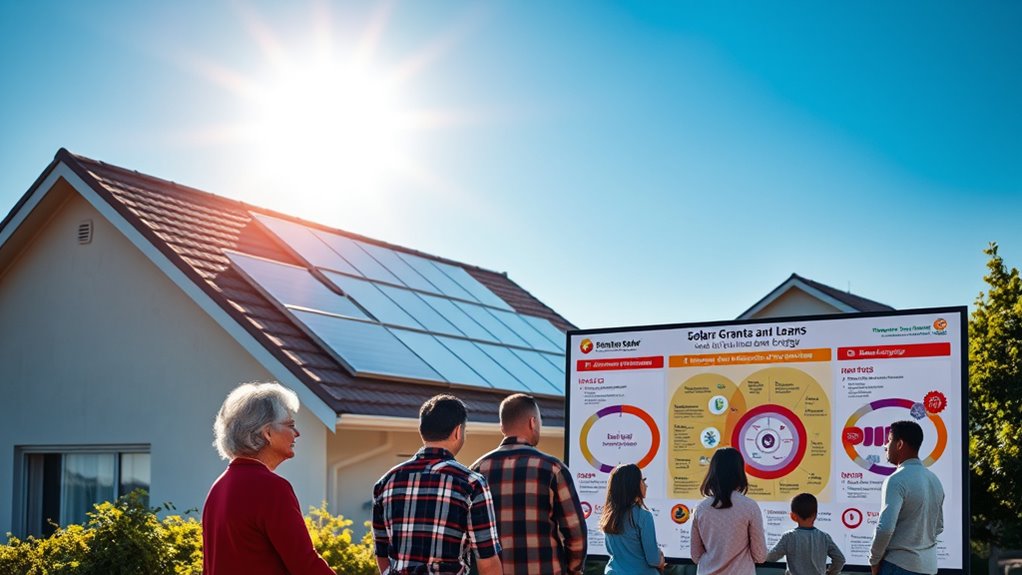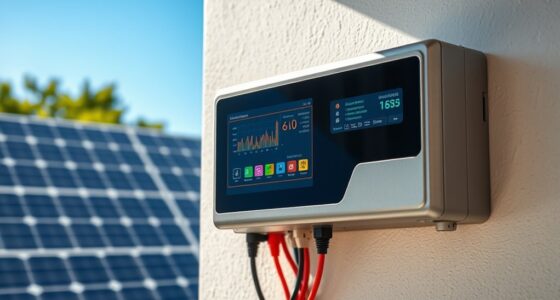If you’re a low-income homeowner considering solar, grants provide upfront savings by reducing or covering installation costs, making solar more accessible. Loans, on the other hand, let you finance your system now and pay over time at low interest rates, often with long-term savings. Both options have benefits and drawbacks, so understanding how they work is key to choosing the best fit for your budget and energy goals. Keep exploring to learn more about making solar affordable for you.
Key Takeaways
- Grants offer non-repayable funds, reducing upfront costs, ideal for tight budgets, but are limited in availability and amount.
- Loans enable system ownership with manageable payments and potential long-term savings, often with low interest rates.
- Grants target low-income households, helping expand solar access without debt, while loans can be more flexible with qualification criteria.
- Incentives like tax credits and regional programs lower overall installation costs, benefiting both grant and loan recipients.
- Combining grants and loans can maximize financial benefits, making solar more accessible and affordable for low-income homeowners.
Comparing Funding Options: Grants and Loans
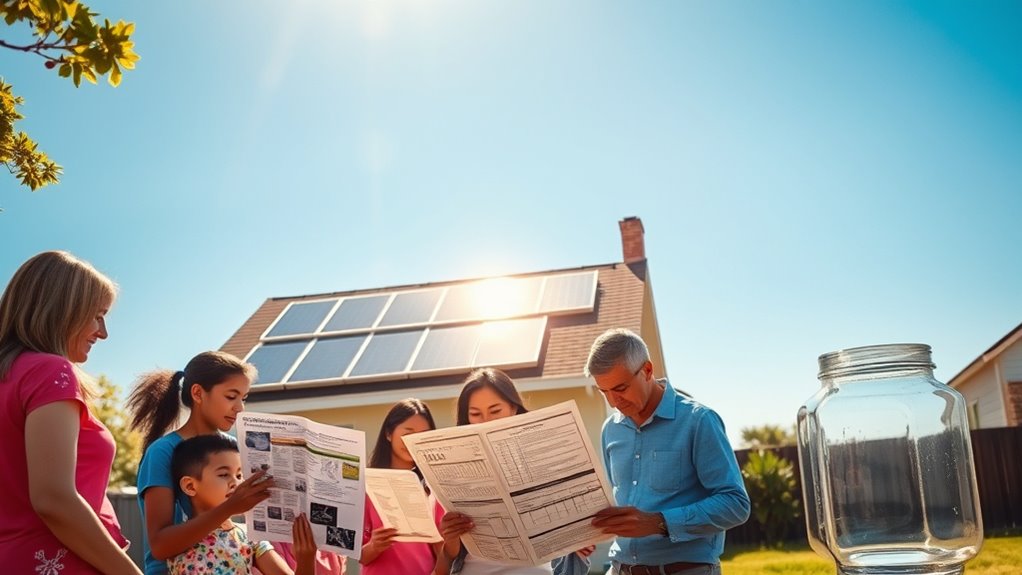
When choosing between solar grants and loans, it’s important to understand how each option impacts your finances and ownership. Grants offer non-repayable funds that reduce your upfront costs, but they’re often limited in availability and amount. Loans, on the other hand, provide larger sums and allow you to finance your system, but you’ll need to make regular payments with interest over time. Solar loans typically have low-interest rates between 2.99% and 6%, with flexible repayment terms from 5 to 20 years. Unlike grants, loans establish you as the system owner from day one, making you eligible for tax credits and incentives. While grants don’t affect your credit, loans may involve credit checks but often accept lower scores and alternative data. Each option has distinct financial implications, so consider your budget and long-term goals. In addition, many low-income loan programs feature low or deferred payments during installation and offer flexible qualification criteria to help more households access solar, especially when considering the importance of credit requirements in financing options.
Benefits and Drawbacks of Solar Grants for Low-Income Families
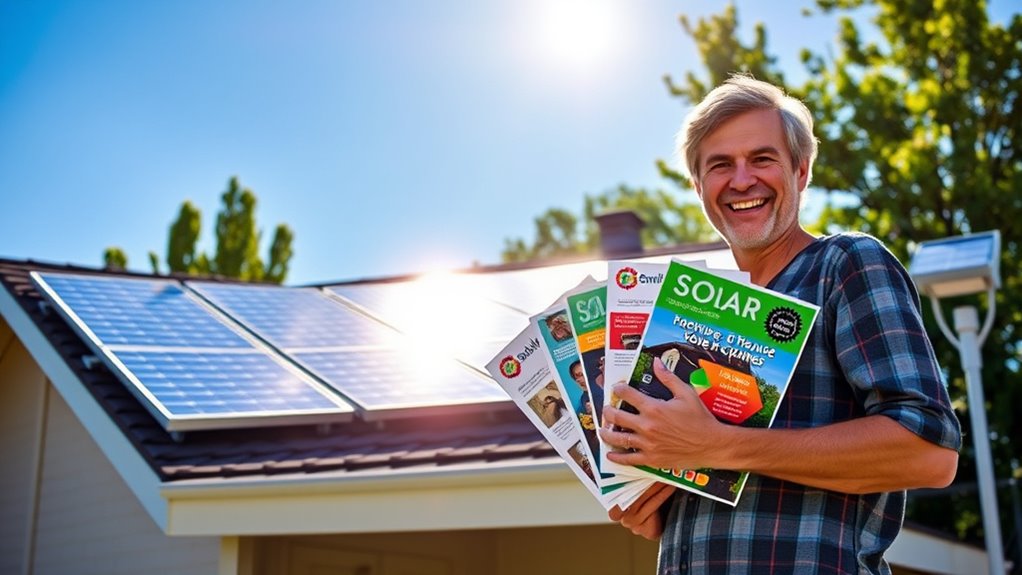
Solar grants for low-income families offer significant benefits by making renewable energy more accessible and affordable. They lower upfront costs through rebates or no-cost installations, helping families reduce energy bills long-term. Here’s what these grants can do for you:
Solar grants help low-income families access affordable renewable energy and reduce long-term energy costs.
- Provide direct financial support, making solar systems achievable without hefty loans.
- Target households at or below 80% of the median income, ensuring help reaches those who need it most.
- Expand solar access across diverse communities, including tribal and multi-state areas.
- Reduce reliance on debt, preventing financial strain from traditional loans.
Additionally, programs like the Low-Income Solar Program (LISP) and the Low-Income Weatherization Program (LIWP) specifically aim to increase solar adoption among low-income households, demonstrating ongoing commitment to equitable access. Incorporating equity-focused initiatives helps ensure that renewable energy benefits are shared across all communities.
Understanding Solar Loan Programs and Their Impact

Understanding solar loan programs reveals how they can make renewable energy more accessible, especially for low-income homeowners. FHA solar loans allow you to finance solar panel systems by bundling the costs into your home mortgage or refinance, so you don’t need upfront cash. This spreads payments over time, with monthly savings often nearly offsetting the increased mortgage payment—making the system cost-neutral or even beneficial. These loans offer typical FHA interest rates and terms, which are generally more affordable than private options. They reduce your electricity bills appreciably, boosting your household cash flow without requiring initial capital. Plus, tax incentives and potential cash incentives can provide immediate financial relief. In addition, they often have flexible qualification criteria, making it easier for low-income homeowners to qualify. Overall, solar loans help you own a solar system while maintaining manageable payments and enjoying long-term savings. Understanding solar financing options can further assist homeowners in making informed decisions about renewable energy investments.
How Incentives and Local Programs Enhance Solar Accessibility
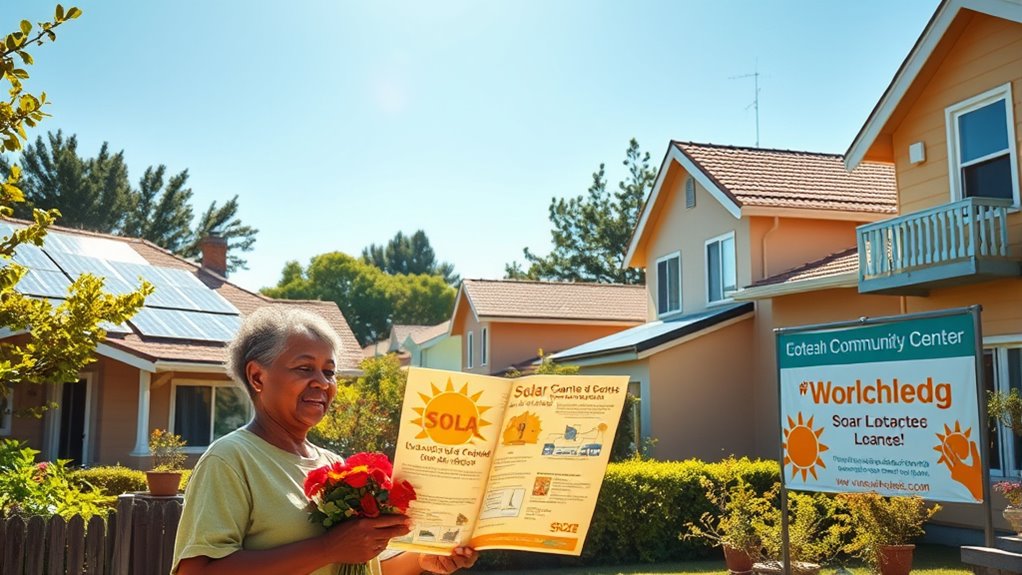
Incentives and local programs substantially boost solar accessibility by reducing upfront costs and making installations more attractive for homeowners. These programs offer multiple benefits:
- Tax Credits and Rebates: Federal, state, and utility incentives cut installation costs, with options like the 30% federal tax credit and state-specific rebates.
- Community Programs: Initiatives such as the Solar for All program target low-income areas, providing grants and incentives to make solar more affordable.
- Property Tax and Net Metering: Some states offer property tax exemptions, while net metering allows you to sell excess energy, lowering your bills. Regional policies can also significantly influence program availability and benefits.
- Educational Outreach: Public awareness campaigns and application portals help you navigate available incentives, increasing your chances to access solar benefits.
Making the Right Choice: Strategies for Low-Income Homeowners

For low-income homeowners, choosing the right strategy to finance solar energy can make a significant difference in affordability and long-term savings. Solar loans often provide immediate bill savings since payments are typically lower than utility costs, creating positive cash flow from the start. Fixed monthly payments also help you budget and protect against rising utility rates. Grants reduce upfront costs, often eliminating or greatly lowering initial expenses, which is essential for tight budgets. Loans, especially government-backed ones, offer low-interest rates and long repayment terms, easing monthly payments. Owning the system through loans or grants makes you eligible for tax credits and incentives, boosting long-term benefits and property value. Understanding your eligibility for specific grants and programs is crucial, as this can significantly influence your financing options and overall affordability. Additionally, being aware of financial planning strategies can help you manage costs more effectively and maximize your investment. Carefully compare options to find the best fit for your financial situation and energy goals.
Frequently Asked Questions
Can I Combine Solar Grants With Loans for Maximum Benefit?
You can combine solar grants with loans to maximize your benefits. Grants help cover upfront costs, reducing how much you need to borrow, while loans provide the remaining funds. By pairing them, you lower your loan amount, save on interest, and boost your chances for tax credits. Just remember, eligibility and restrictions vary, so check program rules and consider consulting a financial advisor to guarantee this strategy works for you.
Are There Eligibility Requirements Beyond Income for Solar Grant Programs?
You wonder if there are eligibility requirements beyond income for solar grant programs. Besides income limits, eligibility often depends on your ownership status, property location, and installation timing. You might need to own your home or property, verify your system was installed after a certain date, and provide detailed documentation like invoices or system plans. Some programs also restrict applicant types, such as tribal governments or nonprofits, and require specific organizational criteria.
How Do Repayment Terms Differ Between Grants and Loans?
Imagine choosing between a free gift and a loan that you’ll pay back over time. Grants don’t require repayment, like receiving a gift—no strings attached. Loans are like borrowing a bike—they must be returned with interest. You make fixed monthly payments, which can stretch over years. Grants ease your upfront costs, but loans involve ongoing payments, making them a longer-term commitment.
What Happens if I Move Before Paying off a Solar Loan?
If you move before paying off a solar loan, the remaining balance usually stays attached to your property. You may need to pay it off during the sale, or the new owner might assume the loan, depending on your lender’s policies. Check your loan agreement for transfer options, and be prepared for possible fees or lien issues. Paying it off early can simplify your move, but review all terms first.
Do Solar Grants Cover Installation Costs or Ongoing Maintenance Too?
You might think solar grants cover ongoing maintenance, but they mainly focus on reducing installation costs. Grants typically pay for the upfront expense of installing solar panels, not the long-term upkeep. While some programs include warranties or support, you’re usually responsible for maintenance after installation. So, it’s smart to budget for ongoing costs, even if a grant helps with getting your system set up and running smoothly.
Conclusion
Choosing between solar grants and loans can seem overwhelming, but understanding your options is key. Did you know that low-income households that install solar panels can save up to 30% on energy costs annually? By exploring available incentives and local programs, you can make a smart, affordable investment in clean energy. Whether grants or loans fit your situation best, taking action today helps you save money and protect the environment for tomorrow.
I’m Theodore, and I love tiny houses. In fact, I’m the author of Tiny House 43, a book about tiny houses that are also tree houses. I think they’re magical places where imaginations can run wild and adventures are just waiting to happen.
While tree houses are often associated with childhood, they can be the perfect adult retreat. They offer a cozy space to relax and unwind, surrounded by nature. And since they’re typically built on stilts or raised platforms, they offer stunning views that traditional homes simply can’t match.
If you’re looking for a unique and romantic getaway, a tree house tiny house might just be the perfect option.
